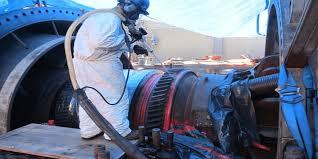How Dry Ice Blasting is Redefining Clean: The Eco-Friendly Solution for Modern Industries
Industrial cleaning is undergoing a transformation. Gone are the days when harsh chemicals, water, and abrasive materials were the only ways to clean machinery and production areas. Today, businesses are turning toward safer and greener methods that not only clean better but also protect the environment. One of the most revolutionary techniques leading this change is dry ice blasting. For a detailed overview of how this process works and its real-world applications, visit Dry Ice Blasting.
What Makes Dry Ice Blasting Different
Dry ice blasting is a cutting-edge cleaning process that uses solid carbon dioxide (CO₂) pellets. These pellets are accelerated at high speed using compressed air and directed onto the surface to be cleaned. When they strike the surface, they immediately turn from solid to gas—a process known as sublimation. This unique reaction removes contaminants like grease, oil, paint, or carbon buildup without damaging the material underneath.
Unlike sandblasting, pressure washing, or solvent cleaning, dry ice blasting doesn’t create additional waste or moisture. The dry ice simply evaporates, leaving behind no residue. This makes it ideal for industries that require precision, cleanliness, and safety.
How the Process Works
The effectiveness of dry ice blasting comes from a three-step physical reaction—thermal shock, kinetic impact, and gas expansion.
-
Thermal Shock: The cold temperature of the dry ice causes contaminants to contract and break their bond with the surface.
-
Kinetic Impact: The pellets strike the surface, further loosening dirt and buildup.
-
Gas Expansion: As the dry ice sublimates, the expanding CO₂ gas lifts and carries away the loosened debris.
This gentle yet powerful process ensures that the underlying surface remains unharmed, making it suitable for delicate machinery and electrical components.
Why Industries Prefer Dry Ice Blasting
Across sectors like food processing, automotive, aerospace, and energy, dry ice blasting has become the preferred method for maintaining equipment. The reasons are clear—it’s fast, non-toxic, and safe for sensitive environments.
One of the biggest advantages is minimal downtime. Unlike traditional cleaning methods that require machines to be dismantled, dry ice blasting can often be done while the equipment is still in place. This helps businesses maintain productivity while keeping operations clean and efficient.
Additionally, because it uses no chemicals or water, it reduces the risk of corrosion and contamination, making it perfect for hygiene-critical industries such as food and pharmaceuticals.
Key Applications of Dry Ice Blasting
Dry ice blasting has found diverse uses across many industries:
-
Food & Beverage: Cleans ovens, conveyors, mixers, and packaging machinery without contamination.
-
Automotive: Removes paint, oil, and adhesives from production lines and molds.
-
Power Generation: Safely cleans turbines, generators, and electrical panels without moisture.
-
Printing & Packaging: Removes ink and grease from rollers and presses.
-
Aerospace: Cleans precision components and molds without abrasion.
-
Restoration: Gently removes soot, mold, and grime from brick, stone, and wood during building restoration.
Its versatility and safety make it a reliable choice for both heavy-duty and sensitive applications.
Environmental and Safety Benefits
Dry ice blasting stands out as one of the most environmentally friendly cleaning solutions available today. The CO₂ used in the process is recycled from industrial byproducts, meaning it doesn’t contribute additional carbon emissions to the atmosphere. Once the cleaning is done, the dry ice simply vaporizes into the air, leaving no toxic waste or water runoff behind.
In addition, it improves workplace safety by reducing workers’ exposure to harmful cleaning chemicals and eliminating the need for manual scrubbing or scraping. The absence of water also prevents bacterial and mold growth, helping industries maintain sanitary conditions.
Cost and Efficiency Advantages
While the equipment investment may initially seem higher, dry ice blasting offers significant cost savings over time. It reduces cleaning time, lowers labor costs, and minimizes production downtime. There are no additional expenses for waste disposal or drying time, which are common in traditional cleaning methods.
The long-term impact is substantial—companies enjoy higher productivity, longer equipment life, and improved operational efficiency.
The Future of Sustainable Industrial Cleaning
As more industries move toward greener technologies, dry ice blasting is becoming a cornerstone of sustainable maintenance. It perfectly aligns with global efforts to reduce environmental footprints while improving operational standards.
With continued innovation, modern dry ice blasting systems are now more compact, powerful, and cost-effective, making them accessible to businesses of all sizes. This technology represents the future of industrial cleaning—safe, efficient, and environmentally responsible.
To learn more about professional dry ice blasting services and explore customized solutions for your facility, visit Top Dry Ice and discover how this technology can elevate your cleaning standards.

